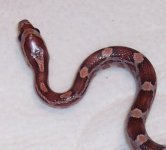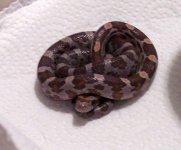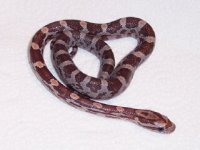Perhaps I should rephrase that into "What SHOULD het bloods look like?"
I have a clutch hatching right now from breeding a bloodred female (one of the old-fashioned looking ones -- deep red/maroon with a mostly white belly) to an un-known hypo anery motley male (bought as a pastel ghost male, but not sure that he's hypo A). Granted, this is the first time I've ever had a bloodred to even breed, so I didn't know what to expect. However, of the nine babies who've hatched so far (seven more to go), they all look like plain old regular run-of-the-mill normals to me. Their heads aren't that gray, and their side patterns look normal, and most of them have normal-looking checkered bellies (except for one who has tiny little checkers along the edges but a plain center line running the length of the belly).
For some reason, I thought het bloods typically showed at least a little influence from the diffused gene. Am I missing something when I'm examining these babies?
As a separate, health-related question, what causes some babies to be born looking dehydrated. Several of the babies from this clutch have skin wrinkles (like a snake that is dehydrated), and the skin seems dryish, faded and crinkly. All of these babies pipped and then remained in their eggs for 12 hours or more, and none of them have been interested in their little water bowls. Yet, they don't look fully hydrated to me. Is there something I should do for them?
I have a clutch hatching right now from breeding a bloodred female (one of the old-fashioned looking ones -- deep red/maroon with a mostly white belly) to an un-known hypo anery motley male (bought as a pastel ghost male, but not sure that he's hypo A). Granted, this is the first time I've ever had a bloodred to even breed, so I didn't know what to expect. However, of the nine babies who've hatched so far (seven more to go), they all look like plain old regular run-of-the-mill normals to me. Their heads aren't that gray, and their side patterns look normal, and most of them have normal-looking checkered bellies (except for one who has tiny little checkers along the edges but a plain center line running the length of the belly).
For some reason, I thought het bloods typically showed at least a little influence from the diffused gene. Am I missing something when I'm examining these babies?
As a separate, health-related question, what causes some babies to be born looking dehydrated. Several of the babies from this clutch have skin wrinkles (like a snake that is dehydrated), and the skin seems dryish, faded and crinkly. All of these babies pipped and then remained in their eggs for 12 hours or more, and none of them have been interested in their little water bowls. Yet, they don't look fully hydrated to me. Is there something I should do for them?





